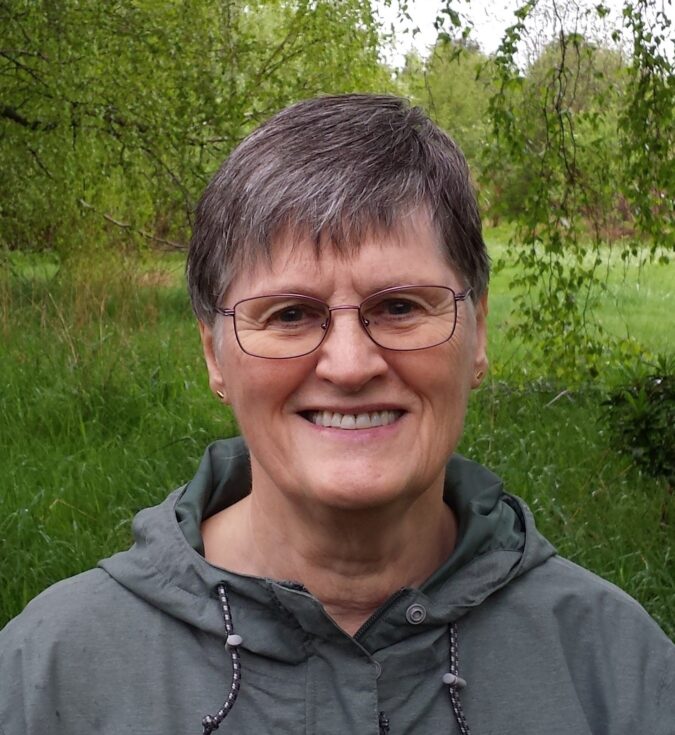oral histories
Marion Smith
I'm pleased with what we've accomplished.
Marion Smith and her friends and neighbours in the Save Richmond Farmland Society worked tirelessly in the 1980s and ‘90s to preserve Terra Nova for agriculture, heritage and wildlife habitat.
Thanks to their efforts, Terra Nova area continues to provide habitat diversity for wildlife and serves as a backshore habitat to Sturgeon Bank. The combination of open fields, ditches, treed areas, landscaped gardens and hedgerows is rare in Richmond and plays a significant role in the ecology of the Greater Vancouver Region, as well as the Fraser River estuary ecosystem.
Can you describe how you got interested in Terra Nova, what the time period was?
This was in the 1980s. I had seen something in the newspaper about public hearings to take Terra Nova out of the land reserve. I knew what the land reserve was and I was familiar with Terra Nova to a certain extent. So, I went to one of the hearings and came home that night and I said to my husband, “People don’t know this is going on. We have to let people know in our area.”
So, we made up a flyer and we called around and asked people who we knew – we didn’t know very many people in those days – if they would take the flyer around our neighbourhood, and they did…. There were a lot of people who would take the flyers door to door. All I had to do was phone somebody up, complete strangers, phone them and say “Would you take these flyers around in your neighbourhood? Would you take 200 flyers and deliver them in your neighbourhood?” and people would say yes. You have to realize, this is before the Internet. This is before social media.
You must have had a vision of what you wanted to achieve and do you think you did that?
Yes, we did. We did. We saved it. Once we saved it though… the issue is it is not nearly as big an area as it was before. Terra Nova in its original form was big enough that a farmer could farm it and not have to move his machinery back and forth along city roads. It was big enough as a whole, intact area for even more than one farmer to farm at a time. So, we ended up with about 100 acres.
Now, we have some original ideas that people have come forth with. We have The Sharing Farm. We have the garden plots. We have the schoolyard gardens. Great things have been done there, I think, just because we had the land and because the city, employees working in parks or wherever, have been able to put forth various projects and they’ve won quite a number of awards for what’s happened at Terra Nova. So, I’m pleased with what happened. I’m pleased with what we’ve accomplished. I walk over there all the time…. It makes me happy to see what we have and to see the birds and see what people are growing in the gardens. Yes it gives me a great deal of satisfaction to know that we’ve accomplished something like that.
Is there anything I didn’t ask you that you would like to share?
…There is a quote that I came across recently. It’s from the 2003 Terra Nova Northwest Quadrant Biophysical Inventory Assessment which is a huge name, but it sums it up.
It says, “The Terra Nova Northwest Quadrant in Richmond plays a significant role in the ecology of the Greater Vancouver Region, as well as the Fraser River estuary ecosystem. The Terra Nova area is particularly important because it provides habitat diversity and serves as a backshore habitat to Sturgeon Bank. The combination of open fields, ditches, treed areas, landscaped gardens and hedgerows is rare in the City of Richmond and it provides a protective habitat for a variety of wildlife.”
What do you see in Terra Nova’s future?
I don’t know. In 1996, I think it was, we gave the city a document called “Investing in Our Future: A City Park in Terra Nova.” We had taken ideas from all over Canada and other places about what you could do there. I was told at one point that they had used some of that when they were planning what the city was going to do with it. after we saved the land.
After the vote and after we knew it was saved there were city consultation meetings with the public: “Okay, why did we save it and what do we want to see there?” The three things were: we saved it for agriculture, for heritage, and for habitat. So, my hope is that all the future goals, all the future projects, stay true to those goals.

